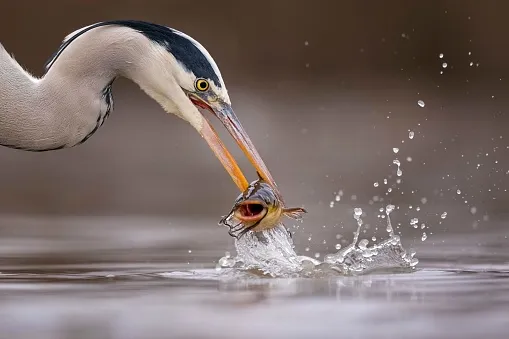All tall, long-legged elegance, with a perky black and white quiff on top, the grey heron is one of our most majestic and instantly recognisable birds. Often seen lurking in the reeds beside canals, standing stock still in the shallows of our rivers, or making daring raids on our suburban ponds, there’s a strange mixture of the exotic and the primeval about the heron.
What is a grey heron?
At 1m (3ft) tall, and with the wingspan of a golden eagle, the grey heron is unmistakable and perhaps that’s one of the reasons why it is so popular. After the mute swan, it is our largest common bird, and you are unlikely to confuse it with anything else in flight either, with its long neck bent and feet trailing behind it.
How many herons are there in the UK?
More than 13,000 heron nests are regularly recorded in the UK, and with 50,000 individuals living here during the winter, the heron has become a common sight along our waterways.
According to John Marchant, from the British Trust for Ornithology, a key reason for the heron’s success has been the improvement in the water quality of our rivers. “The general cleaning up of our waterways, which were in a terrible state due to heavy industry and pollution, has seen fish returning to rivers that were effectively dead. And this is great news for the heron,” he says.
- Britain's urban wildlife: species, identification, how to photograph and where to see
- Best wild swimming spots for seeing wildlife

A fearsome hunter
The heron is a top predator for whom patience is a virtue. It is so often seen motionless by the side of a stream, or carefully picking its way through the shallows, beady eyes focussed on the water for any sign of movement, long neck coiled, ready to strike.
Although it is not fussy about whether it hunts in salt water or fresh, the heron does prefer its dinner to be dead before swallowing it and can often be seen stabbing repeatedly at its prey until it floats motionless to the surface. Fish, frogs and small mammals make up most of its diet, although the heron eats carrion too, and it has been filmed catching rats and even stoats. It has developed a unique method of dealing with furry prey, dipping the victim in water first to soften it up and then swallowing it head-first so as not to go against the lay of the fur.
What are herons doing when they're just standing around?
You may see a heron standing in a field, too, but they aren’t hunting, says John. “They are probably digesting, because they eat very large prey items such as eels, which may be almost as long as them.
“If a heron has swallowed something big, it often flies off to somewhere where it can just stand and digest for a few hours. Often there will be a few herons standing around together.”
The heron has also developed an unusual way of keeping clean, with special feathers on its breast called powder down, which it crushes with its feet into granules and spreads over itself. The powder soaks up the muck and grime from it feathers, which it then scrapes off with a serrated claw. It also helps waterproof the bird, too.

The folklore of herons
Given its looks, habits and harsh, screeching call, it’s little wonder the heron is steeped in folklore. Anglers once believed its feet gave off a scent that attracted fish and often carried a heron’s foot to bring them luck, while fishing lines were anointed with a mixture of rotted heron guts to act as a lure.
The heron was once a regular dish on the medieval banqueting table. Yet as the property of the crown, heavy fines were levied on anyone caught poaching the bird, while in Scotland the penalty was amputation of the right hand. The heron was also considered fair game for hawking, with peregrines in particular flown against the birds.
Despite being solitary hunters, herons like to breed in colonies and heronries have become a noisy attraction in the countryside, a cacophony of squawking and squabbling. Nesting begins in early February, with birds stumbling around in the treetops, either building a new nest or repairing an old one. The heron is a creature of habit, frequently mating for life and preferring to return to the same lofty heights each year.
- Spoonbill vs common crane: What's the difference between these leggy and elegant waterbirds?
- Guide to Britain's geese species: how to identify and where to see
Sometimes herons put on a dramatic courtship display. With the plumes on their necks and crest erect, they’ll twist and turn their long, slender necks, while snapping shut their bills and letting rip with their raucous calls. During the spring the female’s bill also turns a rosy red.
Although some herons may nest on the ground, the majority aim for the trees, simply to be able to rear their young away from predators. But while buzzards and ravens may predate some chicks, a heron’s biggest enemy is a harsh winter. Following 1963’s big freeze, heron numbers dropped by perhaps by as much as half as rivers and ponds froze over, locking herons out of their larders. Fortunately, numbers have increased annually ever since, with the odd shallow dip coinciding with a tough winter.

When is the heron's breeding season?
The heron has a long breeding season and can still be laying eggs in May, with three to four per clutch the norm. The best time to visit heronries, says John, is April and May, when there’s less danger of disturbing the parents. “Go when the young are larger and you can hear them begging for food by making a loud, distinctive rattling noise using their bill and vocals,” says John. “It’s a bit special.”

